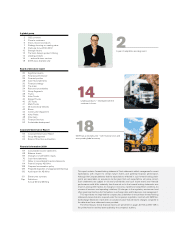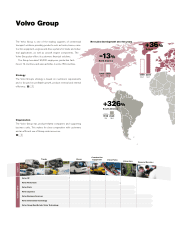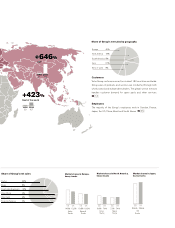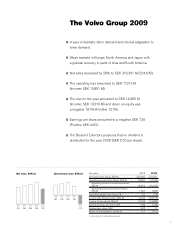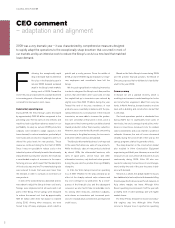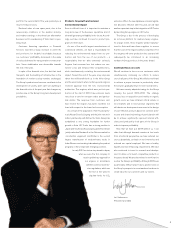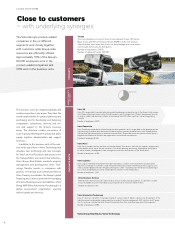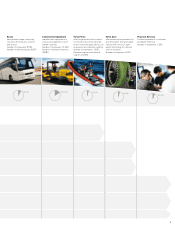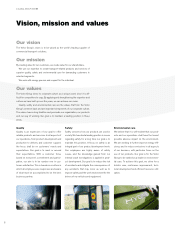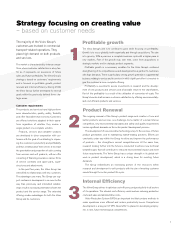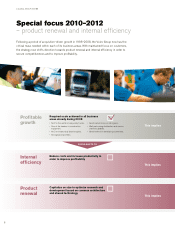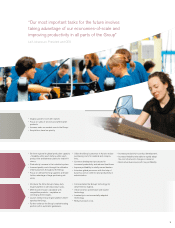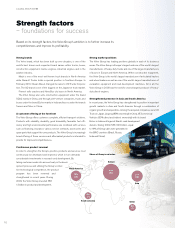Volvo 2009 Annual Report Download - page 6
Download and view the complete annual report
Please find page 6 of the 2009 Volvo annual report below. You can navigate through the pages in the report by either clicking on the pages listed below, or by using the keyword search tool below to find specific information within the annual report.
A GLOBAL GROUP 2009
FBased on the Volvo Group’s losses during 2009
and the present nancial position, the Board of
Directors proposes that no dividend is to be distrib-
uted for the year 2009.
Some recovery
In Europe we see a gradual recovery, which is
resulting in an increase in order bookings for trucks
and construction equipment, albeit from very low
levels. In North America, demand remains on a low
level, with a building and construction market that
is still weak.
Our truck operations posted a substantial loss
during 2009, due to signicantly lower sales of
new trucks, low cost coverage in production, write-
downs on inventories, increased costs for residual
value commitments and costs related to workforce
cutbacks. However, the rate of losses decreased
steadily during the second half of the year as the
savings programs started to generate effects.
The sharp downturn in the construction market
also resulted in Volvo Construction Equipment
experiencing a difcult year. However, as a result of
measures to cut costs, Volvo CE reduced its losses
continuously during 2009. Volvo CE also suc-
ceeded in reducing its inventories of unsold equip-
ment, and by the end of the year they were in bal-
ance with demand.
Viewed as a whole, the global market for buses
has stabilized at a low level, but with demand shifting
from Europe, North America and South America to
Asia, where margins are lower. Although Volvo
Buses’ operating loss increased, it left the year with
a healthy level of order bookings and with higher
market shares.
For Volvo Penta, demand for marine and indus-
trial engines was low. Although Volvo Penta
incurred a full-year loss, it reported an operating
ollowing the exceptionally rapid
drop in demand that resulted from
the crisis in the nancial system in
autumn 2008, demand remained
weak in the Group’s main markets
during most of 2009. Toward the
end of the year, an improvement could be discerned
in increasing parts of the world, although the upturn
occurred from low levels in most cases.
Substantial operating loss
During 2009, the Volvo Group’s sales decreased
by approximately SEK 90 billion compared to the
preceding year. The low sales of new vehicles and
machines had a signicant adverse impact on our
protability. As early as autumn 2008, production
cutbacks were initiated to adapt capacity to the
lower demand, to reduce inventories, particularly of
new trucks and construction equipment, and try to
defend the price levels for new products. These
measures continued during the rst half of 2009.
Since it was not possible to reduce costs in the
industrial system sufciently to match the extremely
sharp decline in production volumes, the result was
a considerable surplus of resources in the manu-
facturing process, which meant that the absorption
of xed costs was very low. The manufacturing rate
was reduced to levels that were even lower than
the demand, in order to cut back on inventories of
new products.
In view of the weak demand, substantial actions
were taken to adjust the Group to lower cost levels.
Savings were implemented at all levels and in all
parts of the Group. These savings were designed
to reduce the annual cost level by approximately
SEK 21 billion when their full impact is reached
during 2010. Among other measures, we were
forced to lay off many employees, which is both a
painful and a costly process. Since the middle of
2008, a total of 18.000 regular employees, tempo-
rary employees and consultants have left the
Group.
We focused a great deal on reducing inventories
in order to safeguard the Group’s cash flow, and the
actions that were taken were successful. In total,
the capital tied up in inventories was reduced by
slightly more than SEK 17 billion during the year.
Toward the end of the year, inventories of new
products were essentially in balance with the pre-
vailing demand. As a consequence of the reduced
inventories, we were able to increase the produc-
tion rate somewhat at that point in time, since a
larger part of the incoming orders could be steered
toward production rather than inventory reduction.
However, since uncertainty still prevails concerning
the recovery in the global economy, the increase in
production will be cautious and gradual.
The Group’s aftermarket business is not exposed
to the same fluctuations as sales of new products.
While the Group’s sales of new products declined
by almost 40%, the aftermarket business, with
sales of spare parts, service hours and other
aftermarket services, only declined a few percent
during the year, which is positive from a protability
viewpoint.
In total, the Volvo Group incurred an operating
loss of SEK 17 billion for the year, primarily as an
effect of the sharply reduced sales volumes and
low cost coverage in our production. As a conse-
quence of the nancial crisis and the subsequent
recession, we also had to take considerable costs
for, among other measures, workforce cutbacks,
write-downs on inventories and increased provi-
sions for residual value commitments and expected
credit losses.
CEO comment
– adaptation and alignment
2009 was a very dramatic year – it was characterized by comprehensive measures designed
to rapidly adapt the operations to the exceptionally sharp downturn that occurred in most of
our markets and by an intensive work to reduce the Group’s costs to a new level that matched
lower demand.
2


